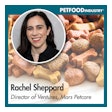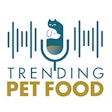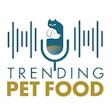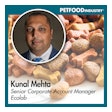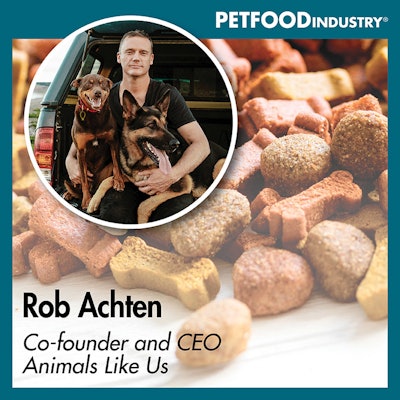
In the latest episode of the Trending: Pet Food podcast, host Lindsay Beaton, editor of Petfood Industry magazine, discusses with Rob Achten, cofounder and CEO of Animals Like Us, his company's strategy for breaking into the North American market, emphasizing the importance of understanding local consumer behavior and regulatory requirements. Achten highlights their initial success in New Zealand's grocery and pet specialty sectors and their cautious, research-driven approach to entering the U.S. market.
The below transcript is from Episode 63 of the Trending: Pet Food podcast, where host Lindsay Beaton talks with Rob Achten, cofounder and CEO of Animals Like Us about the challenges and opportunities of introducing a new pet food category into the North American market. You can find the episode at Trending: Pet Food, on SoundCloud or on your favorite podcast platform. This episode originally aired on June 5, 2024.
We want to thank Cargill for sponsoring this podcast. Cargill, a world leader in pet food ingredients and manufacturing, proudly offers TruMune postbiotic. TruMune is made to help modern pet food brands stand out by supporting multiple trending health claims — like gut health, balanced immunity and pet vitality. Best of all? TruMune benefits are packed into a single, low-inclusion ingredient, and it’s backed by several pet-specific research studies.
Lindsay Beaton – editor, Petfood Industry magazine, and host, Trending: Pet Food podcast: Hello, and welcome to Trending: Pet Food, the industry podcast where we cover all the latest hot topics and trends in pet food. I’m your host and editor of Petfood Industry magazine Lindsay Beaton, and I’m here today with Robert Achten, cofounder and CEO of Animals Like Us. Hi Rob, and welcome!
Rob Achten, cofounder and CEO of Animal Like Us: Hi, Lindsay. How are you doing today?
Beaton: I'm doing well. In case you’re not familiar with Rob or Animals Like Us, here’s what you need to know.
Rob lives with his family and pets in rural Hawkes Bay, New Zealand. His first dog, a rescue named Trixie, sparked his love for animals and belief in their positive impact on families. A former multisport athlete, Rob spent over a decade with global outdoor brand Icebreaker, eventually becoming Global Creative Director and VP of Product. Now, inspired by his love of animals and sustainable living, Rob is the cofounder and CEO of Animals Like Us.
Animals Like Us is a pioneering force in pet nutrition, cofounded by Jeremy Moon and Rob Achten in 2019. The company is dedicated to creating innovative and affordable dietary solutions that harness the best of science and nature and is headquartered in Hawke’s Bay, New Zealand.
Animals Like Us has recently debuted in the U.S., which is why I’ve brought Rob on today to answer this question: What is it like to break into the North American pet food market?
Now Rob, when I talk to owners and co-owners of companies, I always like to hear their origin story. How did you get started in the pet food space?
Achten: I should start off by saying that my background is design. I'm a designer brand guy. I started off my career at a design agency for about 10 years, and I was a creative director for Icebreaker apparel business. That’s my background.
About five years ago, I was asked to do a research project. I had drifted into customer research, and I was asked to do a research project, which was in the pet space, in China. I had a couple of trips to China, and we were interviewing pet parents. We went into people's homes, and we were researching the behaviors and preferences of Chinese consumers and how they were looking after their pets. That’s how I stumbled into the industry, and was absolutely fascinated by what was happening, particularly in that market at the time, because they're fairly new to pet ownership. It's sort of happened in the last couple of decades, and it's just been massive growth. It's led by young people, so very youthful, very female dominated. It's almost a cultural movement, like a fashion movement. As a designer and a researcher, that got me really interested.
In the process of doing that project, I learned a lot about nutrition. I was going through a period of my life where I was also trying to think about healthy eating for myself. I had that in my mind, and I was studying all these pet food brands. Then at the same time, back home in my little orchard in Hawke's Bay with my three dogs, I was thinking about what's the best diet to give my dogs. I was experimenting with different types of food. I guess the undertone to all of that is that I had this desire to feed my dogs the most natural diet as possible, like what they should be eating.
I was experimenting with raw feeding. I had a separate refrigerator where I would have food, frozen food or defrost it overnight. I'd mix that with the best kibble I could find, and I just started experimenting. Then my previous boss from Icebreaker, Jeremy, heard about what I was doing, and he was doing something very similar. He had a dog, and he was experimenting with food. The two of us started comparing notes and talking about what's the right food, what's the right diet to feed our dogs. We started hacking and building our own food. We thought, “Hey, there's an idea here that the food that we want to give our dogs doesn't exist, and we think we're onto something.”
That was the origin of the idea four or five years ago. I've always been an animal lover. I was given my first dog when I was two years old, and he lived to age of about 18 years old. Essentially, my best friend growing up was my little pet dog, so I was always very attached to him.
Animals have always been a part of my life. They've always been part of a family. I've always had this belief that having a pet in your family just makes your family so much better. There are so many benefits. That's a long answer, Lindsey to your question.
Beaton: You talked about not being able to find the food that you were looking for. What is the domestic pet food market like in New Zealand? What gave you the impetus to try to break into it? What was your market research finding, and how were you able to fill a gap in the domestic market?
Achten: Pet food globally is dominated by kibble, which is the dominant product that's fed to dogs, and it's heavily processed. There are good versions of that and bad versions of it, but it's heavily processed and it's convenient. It's an easy food solution.
I was looking to not completely do away with kibble. I just wanted to introduce more natural raw food into their diet. It's a bit like our own diets, you have processed food during the day, but you don't want to just live on 100% processed food. You want to bring in as much natural whole foods as possible.
We're not purists. We're not trying to create something that extreme. We're trying to create a good, practical balance, where dogs get all the nutrition that they need, but it's still a convenient solution
The New Zealand market was reflective of the U.S. market. The U.S. is further ahead in raw feeding. There are a lot more raw or raw alternative products on the market, but the general landscape is dominated by processed food. A lot of that is using ingredients that are questionable and using a lot of starch and fillers. That’s what we're trying to move away from.
Beaton: As you got your company off the ground and started producing food and selling it, what outlets did you focus on to sell the food? When was your aha moment where you went, “We're going to succeed at this, and we can probably make it bigger?”
Achten: We looked at the New Zealand landscape where pet food is sold, and that 75% of food in New Zealand was sold in a supermarket. About 15% is sold in pet specialty stores. The natural place for us to start, because we had a premium, mid-price to high price product, was in pet specialty. That's where everyone was telling us -- that's where it belongs.
What we couldn't reconcile is that our shopper goes to the supermarket every week, and they've kind of given up on the pet aisle because they can't find a good premium product there. We thought the whitespace is really in grocery and supermarkets as opposed to pet specialty.
Now this is a New Zealand dynamic; it’s different than other markets. We decided not to do the safe option. We decided we're going to try to create this premium category in the supermarket. We launched our very first dog food product in the supermarket, and it was three times the price of the next base product. Everyone thought we were a bit crazy, but we've done a lot of research. Our background was design and marketing and branding. We felt confident that we could put a product on the shelf and drive people into the supermarket, tell them, “That it's on a shelf.” They’re going there once a week, and we just needed them to go down that pet aisle.
We launched with quite a bang. We did a lot of advertising, a lot of digital advertising, a lot of billboard and outdoor advertising near the stores. For the first couple months, it was a bit slow, feeling a little bit nervous. Then it blew up around the third or fourth month. Now, three years later, it's one of the best performing products in the supermarket.
We quickly realized that we were addressing a part of the market, it was really the shopper that was going in for their weekly grocery purchase. They'd buy a small pack, and it would last a week. But there was still a consumer that wanted to drive to a pet specialty store and buy a month's worth of product. We came up with a more premium range where we added more raw ingredients into the diet. We launched it about a year later to pet specialty.
In the New Zealand market, we've got two different ranges, one in the grocery that's a lower price with a more premium price in the pet specialty stores. That’s how we developed in New Zealand. Typically, the pet specialty stores don't want to brand your product if you're in the grocery. We were one of the few brands that managed to create one brand, but two distinct product ranges and two different price points. They coexist well in both channels. That's how we've built the business in New Zealand and Australia because we're doing the same thing in Australia as well.
Beaton: Let's talk about North America. As you tangentially mentioned earlier, it's a pretty crowded market over here. The raw and fresh-frozen and the mix are all part of a growing market here. There's still quite a bit going on. When did you look over here and say, “I think it's time to tackle the most mature market in the industry.” How did you go about doing it?
Achten: We took our time. We really wanted to make sure our product was working and if we needed to make any refinements. We weren't rushing to export our product. We really wanted to fine-tune the product and scale the supply chain as well.
We first started looking at the U.S. about two years ago. Myself and my business partner, Jeremy, we just jumped on a plane and went to Super Zoo. It was our first trade show, and we were like a deer in the headlights of a car. We were thinking, “Wow, what is this place?” We were complete novices, but it was fun and exciting. We were soaking it all in, learning about the industry, wanting to talk to anybody. We would just walk up to a booth and start talking to people. They thought we were a bit strange with our Kiwi accent, but most of them were happy to talk to us.
We were trying to understand the industry. Then we spent a week or so looking at retail stores, trying to understand the different types of retail outlets and understanding the competitor set we're playing in. We had a couple of trips like that, because from my background in the apparel industry, the principle that I hold dear is that you need to really understand the market and you need to understand the consumer. The best way to do that is go into the market and immerse yourself in the market, Talk to retailers, talk to consumers. That’s what we did.
We formed a hypothesis on where we thought we could play, in what channel. We purchased some Nielsen data and analyzed the different channels, the different brands, the different price points. We were looking for that whitespace.
We also showed people our product packaging, and we got a lot of feedback. Then we went away. We had a bit of a hypothesis that we were testing. We thought that we needed to change a few things to get our proposition optimized for the U.S. market.
We embarked on a packaging change out, a redesign. We had our existing packaging, and we had our new packaging. We did a consumer research project with 400 American pet food consumers. We were testing old packaging against new packaging, and that was a hugely valuable exercise because we needed to make some changes to the packaging.
That was all about a year where we were going into the U.S., doing a lot of study tours, a lot of meetings with retailers during the consumer research. Then we found out that we were ready to start pitching to customers.
We're also trying to understand the distribution model because it was very different. It felt very complicated for us coming from a small country of 5 million people. That's very simple. The U.S., you've got layers of distribution. You’ve got the big distributors and manufacturing reps. For us, it took us a little while to understand how all that worked. The good thing is, when we came back with the new packaging and product, everybody was excited by what we had.
We were designing for whitespace. We were designing for a specific price point. They could see our thinking. They could see the product was visually different. It wasn't another “me too” product. We had a tremendous amount of positive response to the brand and the product.
We then decided what our business model was going to be. We needed to have a partner which was going to do the distribution piece. We signed up for Phillips Pet Food & Supplies last year. They were excited about our whole proposition. We launched at Global Pet Expo in March.
It wasn't a quick thing. It was a quite a slow, thoughtful process. We did a lot of feedback loops and a lot of consumer research. We made some changes to get it right for the U.S. market.
Beaton: You launched in March, and as we're recording this, it's toward the end of May. This question is only going to cover a couple of months or so, but what has the initial feedback been like? From a business perspective, has it gone the way you expected it to? Are there already things that you're thinking you're going to have to modify over the next several months?
Achten: We're really pleased with the number of doors that we've opened. It’s been on the shelf just over a month, and the data is looking good. We're encouraged with the doors that we’re opening and the sell-through.
The thing we're really thinking about now is the U.S. is such a big country, how do we build the team in the U.S.? We believe we've got a unique proposition; the brand is fresh and different. We're onto something. How do you wrap around the team and the resources? That's a work in progress. That's the piece we're trying to work out right now.
Beaton: Where did you initially launch? I don't think I asked you that. Did you stick with pet specialty over here?
Achten: Yes, we did. The data told us that the U.S. market was very different. We don't have plans to do grocery at all. We launched our RawMix50, which is our premium product range -- a 50% mix of freeze-dried organ meat and 50% kibble – that we launched into the U.S.
We're focused on building pet specialty. We're very singularly focused on that. That's what we're going to be doing for the next two or three years.
Beaton: You spoke about having to change the packaging, and you spoke about the multi-layered distribution models that go on in the U.S. Were there any other barriers to entry you felt you had to overcome? What was the regulatory side of things like?
Achten: The regulatory piece -- we had to make a few changes to a recipe. We needed to do that in any way because we wanted to make some improvements. Understanding the compliance and regulatory issues … it just takes a bit of time. It's not a quick thing to work through. We probably underestimated the length of time it took to get the permits and so on.
The main changes that we made to our packaging was really to hero our product. Our product visually is very different. It looks like a trail mix or a good granola. We can see the different natural organs, because we use a high percentage of organ meat. It's not organs all mixed up. It’s the whole organ meat diced, so what you get is interesting different shapes of the heart, the liver, the lung, the green tripe, etc., and that's all mixed with a kibble. It ends up looking like a trail mix. Our product is so visually interesting and different, we wanted to really highlight that and hero that on the pack and show off its great ingredients.
Beaton: We've talked about your origin story, we talked about how you got here, we've talked about the launch, and we've talked about what you're expecting to do in the short term. What are your next plans for the future of your company in North America? What's your five-year plan now?
Achten: We probably haven't jumped to five years yet. Really, we’ve mapped out the next three years. We believe we're creating a new category where that product type and the price point doesn't exist. You've got premium kibble, you've got kibble with a little bit of freeze-dried added to it, and that's at $5, $6 or $7 a pound. Then you've got your 100% freeze-dried that can be as expensive as $40 or $45 a pound. We've sort of split the difference with a 50/50 mix that doesn't exist. We see ourselves as category creators. That takes time. That means that we're educating customers on a product they haven’t seen before. We're digging our heels in and prepared that this is going to take a bit of time to build out a category and build our brand in the market.
We want to own this category within pet specialty. We’ll play online, I think. In the U.S., a lot of consumers -- 30% plus -- look to buy online, so we'll have an online presence as well. Those are the two channels that we're going to focus on in the immediate future.
We don't have plans to do grocery though. The U.S. is a big enough place where we can have a strong presence within the pet specialty and online space. The focus really is building the team to serve our customers, so we can deliver a good service to our customers and to our end consumers.
Beaton: Well, thank you so much for being on the show today, Rob. It has been interesting to talk to somebody who is breaking into the North American market, because from this side of things, it's really crowded, and even domestic companies have to take a really hard look at their business plans to figure out how to find that whitespace.
It's always interesting to talk to somebody who's coming in with a new type of product -- who's coming in from the outside and looking at our regulatory process and our retail process and seeing how complex it can be and navigating that. So, thank you very much for speaking with me about all of that today. I really appreciate it.
Achten: Thanks, Lindsay. It was fun having a chat with you.
Beaton: Before we go, let’s do a little plug: Where can people find more information about you and Animals Like Us?
Achten: They should probably go straight to our website, which is animalslikeus.com. We have all our retailers listed there so you can find a store, hopefully near you, where you can buy. Our product will be on Amazon in a couple of months’ time as well. Animalslikeus.com is the best place where you can learn all about our product and go from there.
Beaton: Perfect. That's it for this episode of Trending: Pet Food. You can find us on petfoodindustry.com, SoundCloud or your favorite podcast platform. You can also follow us on Instagram @trendingpetfoodpodcast. And if you want to chat or have any feedback, I'd love to hear from you. Feel free to drop me an email: [email protected].
And of course, thanks again to our sponsor, Cargill. This world leader in pet food ingredients and manufacturing proudly offers TruMune postbiotic. TruMune is made to help modern pet food brands stand out by supporting multiple trending health claims — like gut health, balanced immunity and pet vitality. Best of all? TruMune benefits are packed into a single low-inclusion ingredient, and it’s backed by several pet-specific research studies.
Once again, I'm Lindsay Beaton, your host and editor of Petfood Industry magazine, and we'll talk to you next time. Thanks for tuning in!












